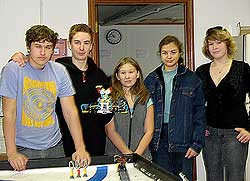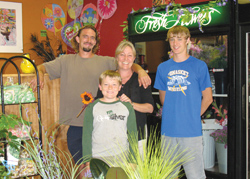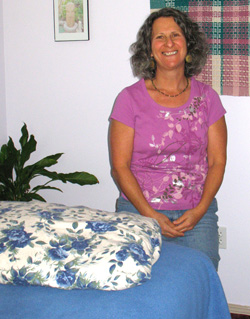
Team “Green Edge,” (L-R) Teen coach Jonathan Snyder, Dan Kiesecker, Robin Snyder, Elizabeth Clemen and Lindsey Prince. The team won a berth to the state tournament held Dec. 8 in Bellevue, team coach Martha Bosch said. Inspired by the Sunny Okanogan,
TONASKET – Green energy is more then a campaign idea to five Tonasket students.
For them, green energy is fun, exciting – even educational.
“Green Edge,” a team from Tonasket Middle School, has spent the last month and half – or so – putting together a green robot and designing a green house for FIRST Lego League (FLL).
FLL is an international competition organized by FIRST, or For Inspiration and Recognition of Science and Technology, an organization founded “to inspire young people’s interest and participation in science and technology through teamwork and problem solving,” according to a press release issued by FLL.
FLL created the challenge, released Sept. 5, calling for teams of students age 9-14 in the U.S. to use robotics to understand and create solutions for energy management and conservation.
The League was created in 1998 when FIRST and The LEGO Group joined forces.
More then 10,000 teams in 38 countries will participate in this years challenge, according to the press release.
The Tonasket team – Elizabeth Clemen, Dan Kiesecker, Lindsey Prince, Robin Snyder and teen coach Jonathan Snyder – traveled to Moses Lake for the regional competition Dec. 1. The top five teams at regional’s progressed to state.
Team “Green Edge” will represent Tonasket at the state competition Dec. 8 in Tacoma, according to team coach Martha Bosch. “The kids are thrilled and excited,” she said.
“We won a place at the state competition!” Bosch said. The team robot also won the “Robot Performance Award” at the Moses Lake Regional Qualifier.
Six tournaments occurred across the state Dec. 1, depending on where teams were located. Other regional competitions were held in Edmonds, Richland, Seattle, Issaquah and Des Moines.
The robotics project has two different sides that come together for the same end, said Clemen.
“The farms grow the corn, which the robot harvests and takes to the power plant, which is converted to energy for the house,” she said. “Part of the competition is the presentation, which we have to apply to help the community around us.”
The team will present the energy-efficient house they designed to Habitat for Humanity Dec. 18 in Tonasket. Habitat may option to build their design in Tonasket, Clemen said.
The house the five students designed has a series of heat-efficient windows facing south, and uses a Russian Stove to heat the place, conducting heat through a series of chambers. A fire has to be lit once, maybe twice, a day to keep inhabitants warm, said Kiesecker.
The robot has to accomplish a series of missions in order for the process to be complete, he said. Missions can include switching a (Lego-sized) fuel-greedy truck for a hybrid car, attaching solar panels and other such activities.
The robot has a computer “brain” which is programmed with missions. The brain can hold about five missions at once, said Kiesecker. There are three rounds per competition, and three missions per round, he said.
Last year, the Tonasket team attended a local competition with Omak and did well, said Kiesecker.
But the project was simpler, Prince said. Prince was the only member who attended last year.
They got their idea – solar panels, utilizing the sun, farming – from the region, said Kiesecker. They took inspiration from the “Sunny Okanogan,” he said, and wanted to manipulate the sun’s power.
Though the experience has been education and thorough, it’s been more then just work.
“It’s been a lot of fun,” said Kiesecker. “It’s been really interesting exploring this, and the computer stuff and robotics. I really enjoyed it.”
The kids also got a social benefit from it, Prince said.
“It was really neat. And, none of us really knew each other before this,” she said. “We’ve all spent so much time together and really gotten to know each other well.”
The team has learned a lot – about fuel efficiency, designing houses and “so many more things,” said Prince.
“They’re great skills for the future,” Kiesecker said.
Since beginning to work on the project, the team has spent most school days working, sometimes spilling into Saturday, if necessary, Prince said.
“The majority of the last month and a half has been spent here at some point during the day,” Kiesecker said.
On average, it’s been about 12 hours a week, said Angela Lorz, one of the coaches.
“These kids have shown a lot of native ability as well as tremendous responsibility,” she said.
The competition in Moses Lake was the first for any of the team, said Bosch.
“I’m so proud of the kids,” she said. “They’ve worked so hard. The robot ran fantastically and they were always ready to fix anything and if they saw something they liked they ran back to fix it. They did great.”
Now, it’s back to work – if you can call it that – for the team.
“They’re anxious to get back to work this week, fixing the robot up and getting ready,” she said. “I imagine we’ll work on it all week.”
Bosch leads the GEAR-UP program for the Tonasket School District. GEAR-UP, or “Gaining Early Awareness and Readiness for Undergraduate Programs,” is the umbrella organization which the robots, Educational Talent Search and many other programs fall under.
This is Bosch’s third year working on the Lego robotics project.
One of the challenges in the program is trying to find funding to take kids on the trips across the state. The State competition for the robotics team is in Bellevue Dec. 8.






